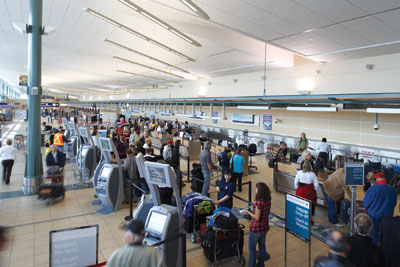
Features
Operations
Waypoint: Pat-down payoff!
Aviation regularly gets its share of media attention regardless of whether it’s commercial, corporate, private or military.
February 24, 2011 By Rob Seaman
Aviation regularly gets its share of media attention regardless of whether it’s commercial, corporate, private or military. For example, airline pilots showing up for work drunk was a popular news item for a while. And then there was the front-end guys caught sleeping on the job. A real eye-opener. A couple of off-runway trips? Another great piece.

|
|
Negative news stories like these really don’t do much to build the confidence of the travelling public. This, of course, is compounded by the fact that when taking a commercial flight, you can’t bring much on board, you must arrive hours beforehand to go through the humiliation of pre-flight screening, and you get treated with little customer service acumen – regardless of whether you’re a member of the flight crew or a passenger. From the passenger perspective, it begs the question: do I really want the folks entrusted with the operation of the aircraft and my safety rattled and flustered because of overt security measures?
Gone are the days when heading out on a plane was a thrill and an adventure for the family to enjoy. Gone too are the times when a business trip between cities was routine and the travel just part of the process. Commercial air travel is a task – a temper-testing process of humiliating, impersonal actions. Small wonder everyone looks angry in commercial airports today.
And every time terrorists (or troublemakers/pranksters) come up with a new scheme – such as printer cartridges that are actually bombs – everything is ratcheted up a notch. The Transportation Security Association (TSA) goes on high alert and, because we are great neighbours, Transport Canada has to follow.
The latest wrinkle in airport security to enrage both flight crew unions and passengers is the introduction of full-body scanners and enhanced body search methods. These intense security measures have prompted mass protests and dramatic acts ranging from stripping to threats of organized mass refusals. The new tactics have prompted claims by some over “familiarity” in the search methods, and social networking sites including Facebook have groups devoted to it. There’s also a raging debate about what actually happens to the images that are generated by the scanners. Authorities swear they are destroyed; others swear not.
It’s a gigantic mess for all concerned; however, business aviation is benefiting from it all on many levels – it’s helping to stimulate business. Every time a businessperson familiar with the benefits of corporate aircraft use is subjected to the rigours of commercial travel, bizav gets a second chance. To wit, corporate flight department hours increased in 2010 – and according to some, are almost back to pre-recession numbers. By the end of the year, charters in Canada were healthy again, and some weeks, getting an aircraft was a challenge, according to some major Canadian aircraft management groups.
The same holds true in the United States. Case in point, a recent report in the Boston Globe indicated corporate jet activity was up seven per cent through 2010 at Hanscom Field, a small general aviation airport close to the city. Some “based” operators report that their business doubled from the previous year, while others at the site report more modest gains of 15 per cent. Either way, in a conservative, politically driven community like Boston, increases are significant. The report goes on to say new pilots have been hired and the number of aircraft based at the field increased by a third in the past three years – enough that the operators of the aerodrome are talking expansion. Similar news is coming from other spots in the United States and Canada.
As charter activity increases, it creates a trickle-down effect – notably, bizav users who were waiting to move beyond charter and into some form of ownership are now turning to fractional or full-aircraft acquisition.
The order books are also starting to load up again on the OEM side. Montreal’s Bombardier Aerospace, for example, is hiring staff for its corporate aircraft production division, while many forecasters are predicting recovery is on the way – some say in 2012, and others by late this year. Either way, it’s good news.
We really need to thank the TSA, Transport Canada by default and airport screening folks for this turnaround. They have had some impact in the recovery of the corporate aviation market domestically and around the globe. And who knows – if they keep it up, we may be experiencing more good news in the near future.
Rob Seaman is a Wings writer and columnist.